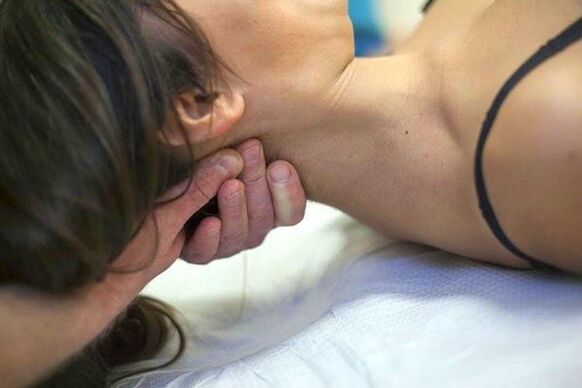Cervical osteochondrosis is a disease of the cervical spine in which the joints and intervertebral discs are destroyed. This disease affects ¾ the world's population over the age of 35.
Cervical osteochondrosis causes much more suffering than its counterparts in the lumbar, sacral or thoracic region, as it contains more nerve fibers.

Classification of characteristics
The symptoms of this disease are related to three main systems of the human body.
- The spinal cord is a violation of its integrity and compression.
- Peripheral nervous system - damage to its fibers.
- The vertebral artery is a disorder of blood flow and oxygen supply to the brain.
Disruption of these systems affects human health. The first symptoms are severe headache.
Pain syndrome
Frequent headaches radiating to the neck are the first signs of the disease. Sometimes the pain migrates to the back of the head or to the shoulders. Unlike ordinary migraine, osteochondrosis of the cervical spine cannot be eliminated with painkillers alone. This problem requires comprehensive treatment.
Lack of air
Symptoms of shortness of breath often accompany cervical osteochondrosis. This is due to irritation of the phrenic nerve. A person suffering from migraine of the cervical spine finds it difficult to breathe deeply, it is especially difficult to catch his breath. At night, patients may have short pauses in breathing, accompanied by snoring. If the room where the patient is, is not ventilated, he develops hypoxia, which leads to impaired memory and concentration.
nausea
Symptoms of nausea occur in diseases such as osteochondrosis of the cervical spine due to impaired blood circulation in the brain. Sometimes the symptoms of nausea are accompanied by vomiting, which occurs when walking, turning and tilting the head. This is due to the lack of oxygen in the inner ear - the place where the center of balance is located.

Change in blood pressure
A person who has been diagnosed with cervical osteochondrosis must constantly tolerate fluctuations in blood pressure. Similar symptoms can occur in both hypertension and hypotension. This is due to poor oxygen supply to the vasomotor center located in the medulla oblongata.
Ringing and tinnitus
These symptoms are associated with damage to the inner ear, as it controls the vestibular system. Sometimes there is a general hearing loss. Such symptoms are called cochlear syndrome by doctors.
seizure
Loss of consciousness or seizures are common symptoms in people suffering from diseases such as osteochondrosis of the cervical spine. The reason for this phenomenon is a pronounced spasm of the arteries, as a result of irritation of the curved bone processes of the vertebrae, nerve endings.
Pharyngeal symptoms
Such symptoms include itching, dryness, or a foreign body sensation in the throat. This phenomenon is associated with a lesion coming from the spinal cord of nerve trunks.
Reduced vision
The eyes also suffer from the appearance of such a disease as osteochondrosis of the cervical spine. Such symptoms as reduced vision occur due to damage coming from the spinal cord to the neurovascular trunks.
Methods of treatment
To date, you can cure neck migraines in the following ways:
- drug therapy;
- physiotherapeutic treatment;
- treatment with folk remedies.
Medical therapy
Such treatment of neck migraine involves the use of tablets and injections of analgesics. This is necessary to eliminate pain in the neck, head and shoulders. Analgesic injections have the advantage of being fast.

It is also necessary to use injections and antispasmodic tablets. These drugs are most effective in eliminating spasms that occur in the arteries of the spine.
In this way, antispasmodics protect the patient from seizures. In addition, antispasmodic injections are used to treat pregnant women. Because these injections are safe for the mother and the unborn child.
Vascular drug-based treatment is also effective.
They help to restore blood circulation in the affected areas of the neck. These injections relieve pain and partially help to get rid of other symptoms.
No less effective is the drug treatment based on the use of chondroprotectors. These drugs stop the progressive osteochondrosis of the neck, restore the cartilage of the joints. The most effective preparations that include collagen hydrolyzate. Because this substance helps to regenerate the cells destroyed by the disease.
Physiotherapy
The treatment of osteochondrosis of the neck with the help of physiotherapy procedures is currently widely used. Most used:
- ultraviolet radiation (UVI);
- vibration impact;
- electrotherapy.
Ultraviolet treatment helps to stop migraines in the neck, thanks to the analgesic, bactericidal and anti-inflammatory effect of the rays. Ultraviolet radiation is used for migraine of the cervical spine in the back of the neck, in the subclavian area or in the upper part of the shoulder blades.
Exposure to vibration, as well as UVI, perfectly eliminates osteochondrosis of the cervical spine. Best of all, vibrations relieve pain.

Electrotherapy treatment allows you to get rid of pain, improve blood circulation, supply oxygen to brain cells. The most effective procedure is transcutaneous electrical neurostimulation.
Folk remedies
From ancient times the compresses of grated potatoes and honey are used to treat cervical migraine. Also an effective remedy for osteochondrosis of the neck was a mixture of radish juice, aloe and liquid honey.
Many healers prepared an ointment based on hop cones and lard. However, the most effective folk remedy for such a disease as osteochondrosis of the neck is a decoction of oregano, chamomile, parsley, nettle and burdock.
These herbs are flooded with boiling water and insist in a dark place for 3 days. Drink this decoction one tablespoon twice a day.
Such alternative treatments help to cope with pain, improve blood circulation and saturate the brain with oxygen, which is so necessary for it.































